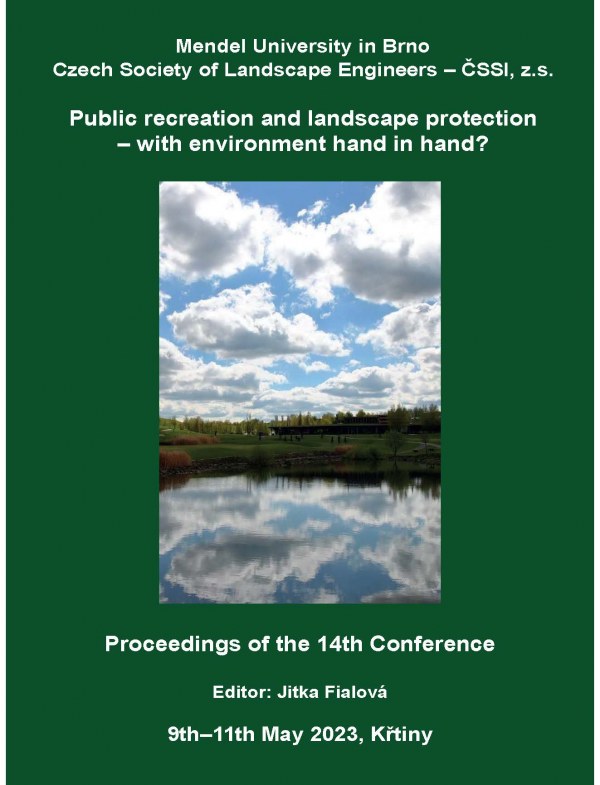
DOI: 10.11118/978-80-7509-904-4-0106
IMPLEMENTATION OF GREEN INFRASTRUCTURE ELEMENTS TO MITIGATE CLIMATE CHANGE AND IMPROVE RECREATION IN THE MUNICIPALITY OF DRIENOV, SLOVAKIA
- Martina Zeleňáková, Natália Junáková
Green infrastructure, as an often-used term in several political documents and strategies of the European Commission dealing with the protection of biodiversity, adaptation to climate change, protection of water resources and flood prevention, serves as a tool to ensure ecological, environmental, economic, social and urbanistic benefits through natural solutions. From a sociological point of view, green areas represent a landscape element with recreational potential in a residential environment. The task of green infrastructure is to connect individual areas of greenery at the level of cities, municipalities and in the open country. Together with the blue infrastructure, it provides various forms of benefit for the population in urban settlements and improves the quality of life. Green and blue infrastructure solutions are particularly important in the urban environment, where more than 60% of the EU population (and approx. 53% of the Slovakia population) lives. The contribution is focused on the design and subsequent implementation of green infrastructure elements in the village of Drienov, situated in the east of Slovakia in the Kosice Basin (Košická kotlina). The goal is to create infrastructure elements and objects that together will create a functional unit and improve the quality of life of people in the village. The goal can be fulfilled by creating several separate objects whose technical and social functions are interconnected. The results of this study are proposed elements as green areas made of semi-vegetated blocks, an underground tank, a rain garden in the exterior premises of the Drienov municipal office and a semi-vegetated retaining wall, which in the future would form a pleasant relaxation zone supplemented by trees, bushes, flowers and benches.
Keywords: green areas, Kosice Basin, rain garden, retention tank, vegetation retaining wall
pages: 106-110, Published: 2023, online: 2023
References
- Balko, Z. et al. (2017). Construction of green infrastructure elements in Slovakia (in Slovak). Banská Bystrica, Slovakia: Slovak environment agency.
- De Sousa, M. R., Montalto, F. A., Spatari, S. (2012). Using life cycle assessment to evaluate green and grey combined sewer overflow control strategies. J. Ind. Ecol, 16(6), 901-913.
 Go to original source...
Go to original source... - European Commission (2021). An EU Strategy on adaptation to climate change. Brussels, Belgium.
- European Commission (2020). EU Biodiversity Strategy for 2030. Bringing nature back into our lives. Brussels, Belgium.
- Hudeková, Z. et al. (2018). Green infrastructure: A guide not only for municipalities (in Slovak). Bratislava, Slovakia: City District Bratislava-Karlova Ves.
- Junáková, N., Zeleňáková, M., Mihaľová, N. (2020). Recreational potential of the Lower Zemplín region in the Bodrog river basin. In: Fialová, J. (Ed.). Public recreation and landscape protection - with nature hand in hand? Conference proceeding. Brno, Czech Republic: Mendel University in Brno, pp. 397-400.
- NC SR - National Council of the Slovak Republic. (2002). Act No. 543/2002 on Nature and Landscape Protection. Bratislava, Slovakia.
- Xu, C., Tang, T., Jia, H., Xu, M., Xu, T., Liu, Z., Long, Y., Zhang, R. (2019). Benefits of coupled green and grey infrastructure systems: Evidence based on analytic hierarchy process and life cycle costing. Resour. Conserv. Recycl., 151, 104478.
 Go to original source...
Go to original source... - Zeleňáková, M., Junáková, N. (2022). Water retention measures as an element of adaptive measures to tackle the climate change in the city of Trebišov, Slovakia. In: Fialová, J. (Ed.). Public recreation and landscape protection - with Environment Hand in Hand… Conference proceeding. Brno: Mendel University in Brno, pp. 446-449.
 Go to original source...
Go to original source...


